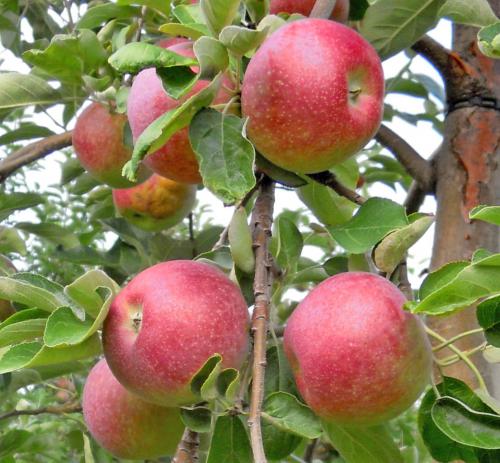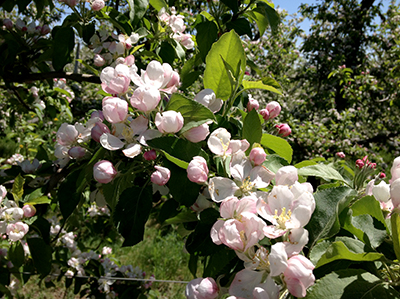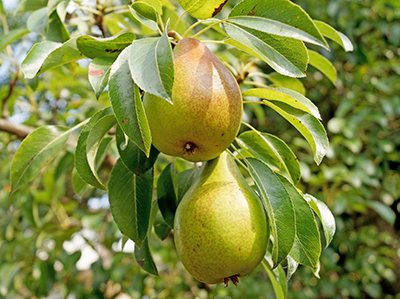
Smart Gardening: Growing Backyard Fruit Trees
DOWNLOADApril 30, 2024 - Revised by Barbara Gregerson & Derek Plotkowski, MSU Extension. Original (2018) by Diane Brown-Rytlewski (retired) & Duke Elsner (retired), MSU Extension.
With planning and patience, growing backyard fruit trees can be a rewarding endeavor. Fruit trees can yield the fruit you like to eat and double as attractive landscape plants. Pick the fruit types and cultivars to grow based on your local growing conditions.
Consider how much space you have, the availability of the cultivar, the cultivar’s pest and disease resistance, and the time and effort you are willing to invest in caring for your tree.
Choosing, Siting & Planting

Consider these points as you choose, site, and plant fruit trees:
- Start with a soil test. Knowing the type, pH, and nutrient levels of your soil is the first step toward successfully harvesting your backyard tree fruit Choose species and cultivars that will thrive in your soil. You can buy soil test kit mailers from your local MSU Extension office or from the MSU Extension Bookstore (extension.msu.edu/bookstore).
- Plant in the right soil. Most fruit trees do well in sandy loam to loamy soils with a slightly acid to neutral pH (6.0 to 7.0). Heavier clay soils can be a problem for fruit trees. If your soil is a heavy clay, you may need to improve your soil drainage by planting your trees on berms or in raised
- Think about cross pollination. Many fruit trees need to be cross-pollinated with another, compatible variety of the same species to produce fruit reliably. These pollinizer trees need to be planted within about 100 feet of the crop tree.
- Know your plant hardiness Winter temperatures will affect the survival of most fruit crops, so choose fruit cultivars and species that are adapted to the U.S. Department of Agriculture’s plant hardiness zone for your area. (See the 2023 USDA Plant Hardiness Zone Map at https://planthardiness.ars.usda.gov/.)
- Give them plenty of sun. Fruit trees need full sun (6 to 8 hours a day). Less than 6 hours a day can slow a tree’s growth, fruit production and
- Give the trees room to Space your fruit trees far enough apart that you will be able to move around the mature trees easily to do maintenance and harvest fruit. If a tree’s tag doesn’t give spacing information, ask someone at the nursery what they recommend.
- Meet the tree’s planting and establishment needs. You can plant fruit trees in fall or spring. Plant them with the graft union about 6 inches above the ground. Water them regularly and thoroughly in the months after planting, until the roots are established and the tree cannot be easily pulled out or moved.
Maintenance
No matter what kind of fruit trees you plant, they will need annual pruning, training, weeding, and fruit thinning. And, depending on your soil test results, they may also need fertilizing.
Most fruit trees are grafted onto rootstocks, which control the size of the trees. Standard trees are the largest type and their branches usually don’t need external support. Semi-dwarf and dwarf trees are smaller than standard varieties and their branches may need trellising and staking to support the weight of their fruit.
You may need to apply pesticides (such as dormant oils or fungicides) to your trees to control pests and diseases to help maintain fruit quantity and quality. Choose pesticides based on the real-time needs of your trees. Thoroughly read all product labels and follow all application instructions to ensure that your application is safe and effective. To protect pollinators, don’t apply insecticides while trees are blooming in the spring.
Specific Requirements
The table summarizes information on mature tree sizes, preferred soil type and pH, hardiness zone, years from planting to first harvest, and other considerations for a variety of fruit trees.
Note: Any fruit tree that is marked in the table as “needs good drainage” or “does not do well in poorly drained soil” can be planted on a berm or mound or in a raised bed to help improve the drainage around it.
Site and cultural considerations for several backyard fruit trees. The information may vary slightly by cultivar.
|
Tree |
Mature height (H) & width (W) in feet |
Soil type, drainage & pH |
Hardiness zone |
Age in years at first harvest |
Other considerations |
|---|---|---|---|---|---|
|
Apple |
Dwarf: 6–10 H & W. Semi-dwarf: 12–18 H & W. Standard: 20–25 H, up to 40 W. |
Sandy loam to clay loam. Needs good drainage. pH 5.5–7.5. |
4–8 (some to zone 3) |
Dwarf: 2–5 (depending on rootstock). Semi-dwarf: 5–7 (depending on rootstock). Standard: 7–10 |
Most varieties need a pollinizer tree. Pests & diseases include apple scab (a fungal disease), codling moth, & fire blight (a bacterial disease) Look for scab- & fire blight-resistant cultivars. Apple-laden branches of dwarf varieties may need support. |
|
Apricot |
Standard: 15–25 H, 20 W. Dwarf: 8–10 H & W. |
Loamy soil. Does not do well in poorly drained soil. pH 6.0–7.0. |
5–8 (some to zone 4) |
2–5 |
Some cultivars need a pollinizer tree. Flowers very early, so spring frosts often cause crop loss. |
|
Nectarine |
Standard: 12–15 H & W. Dwarf: 8–10 H & W |
Does not do well in poorly drained soil. pH 6.0–7.0. |
5–8 |
2–4 |
No pollinizer tree needed. Look for cultivars that resist bacterial spot & brown rot. Less winter hardy than other peaches. |
|
Pawpaw |
15–25 H & W. |
Sandy, well- drained loam. pH 6.0–7.0. |
4–8 |
5–7 |
Needs a pollinizer tree. Tolerates partial shade. |
|
Peach |
Standard: 12–15 H & W. Dwarf: 8–10 H & W. |
Sandy or loamy soil. Does not do well in poorly drained soil. pH 6.0–7.0. |
5–8 |
2–4 |
No pollinizer tree needed. Flowers early, so spring frosts often cause crop loss. Brown rot is a major peach disease. Some cultivars resist bacterial spot. |
|
Pear (Asian) |
Semi-dwarf: 12–15 H, 10–12 W. Dwarf: 8–10 H, 6–7 W. |
Needs well- drained soil. pH 6.0–7.0. |
6–9 (some to zone 5) |
4–6 |
Needs a pollinizer tree. Usually less susceptible to fire blight than European pears. |
|
Pear |
Standard: 18–20 H, 12–13 W. Dwarf: 8–10 H, 6–7 W. |
Needs well- drained soil. pH 6.0–7.0. |
4–8 (some to zone 3) |
4–6 |
Needs a pollinizer tree. Fire blight can be a major problem. Look for resistant cultivars. Pear psylla is a common insect problem. |
|
Plum |
Standard: 18–20 H & W. Dwarf: 8–10 H & W. |
Sandy loam or loam soil. pH 6.5–7.0. |
5–8 (some to zone 4) |
3–6 |
Most Japanese & hybrid plums need a pollinizer tree. Most European plums don’t. Brown rot & black knot are common diseases. |
|
Sweet cherry |
Standard: 18 to 25 H & W. Dwarf: 10–14 H & W. |
Well-drained loam or sandy soil. Will not tolerate clayey or poorly drained soil. pH 6.0–7.0. |
5–8 |
Standard: 6–8. Dwarf: 2–3. |
Most cultivars need a pollinizer tree. Some are self-pollinating. Cherry leaf spot & brown rot are major diseases. Look for resistant varieties. |
|
Tart cherry |
8–15 H & W. |
Mazzard rootstock for heavier soil. Mahaleb rootstock for lighter soil. pH 6.0–7.0. |
4–7 |
3–5 |
No pollinizer tree needed. |


For information on a variety of Smart Gardening topics, visit www.migarden.msu.edu or call the MSU Extension Lawn and Garden hotline at 888-678-3464.
This work is supported by the Crop Protection and Pest Management Program [grant no 2021-70006-35450] from the USDA National Institute of Food and Agriculture.



 Print
Print Email
Email







